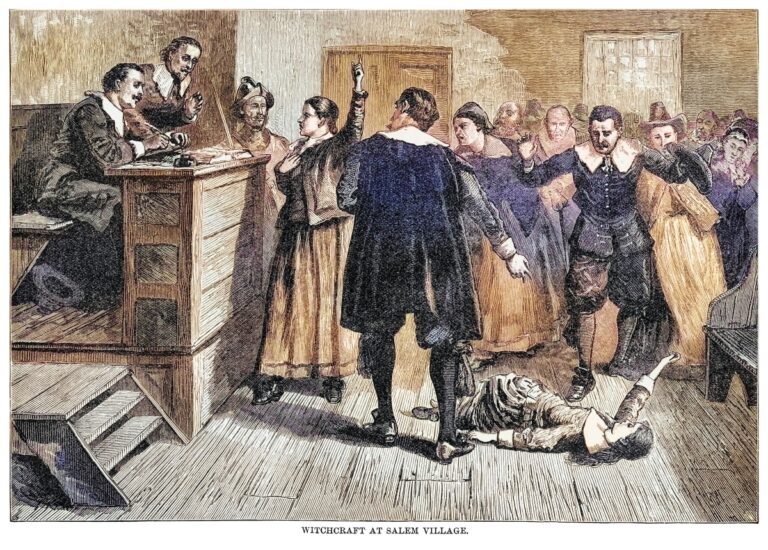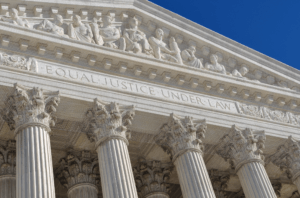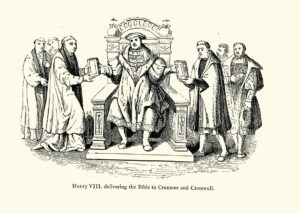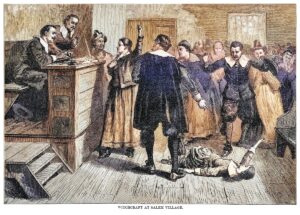A biased court destroyed families in colonial Salem

This article first appeared in the winter 2023 edition of Sword&Scales.
Imagine you are a young child living in Salem, Massachusetts, in 1692.
You are brought into a crowded meetinghouse where two magistrates—both commanding older men who serve on the council of Massachusetts Bay Colony—are waiting to interrogate you in front of an angry audience. In the room is a loud group of teenage girls who say you and your mother are witches.
You are terrified. You haven’t done anything wrong, but everyone is acting like you did. Your accusers say they’ve seen your ghostly specter tormenting them. The magistrates say they already know your mother is a witch.
You’re just a child. You don’t know what to do— so you give the magistrates what they want. You confess. You tell them your mother made you a witch.
Your mother will insist she’s innocent, but it doesn’t matter. The court will use your words against her. She will die by hanging.
Presumption of guilt
Of the 144 people prosecuted at the Salem Witch Trials, eight were children under the age of 12. All eight confessed to being witches and implicated their family members.
This was part of the horror that unfolded at Salem over the course of 1692. Neighbors turned against neighbors; husbands testified against wives; scared children pointed fingers at their mothers.
The youngest convicted child, Dorcas Good, was only four or five years old. She was pressured into speaking out against her mother, Sarah Good, who pled innocent. At the pre-trial examination, conducted in public before the accusers, magistrate John Hathorne hammered Sarah with questions that presumed her guilt.
“Why do you hurt these children?” Hathorne asked, referring to the teenage accusers. “What evil spirit have you familiarity with?”
The way Hathorne spoke to the accused is similar to the way police today are taught to speak in interrogation rooms. The Reid Technique, a leading method of interrogation developed in the 1950s, explicitly instructs police to ask leading questions that presume guilt. “A deceptive suspect is not likely to offer admissions against his self-interest unless he is convinced that the investigator is sure of his guilt,” one textbook says. “Therefore, an accusatory statement such as ‘Joe, there is absolutely no doubt that you were the person who started the fire’ is necessary to display this level of confidence.” This is essentially what Salem magistrates were doing, centuries before it was an established police technique.
But there are two differences between modern police interrogations and the pre-trial examinations of the Salem Witch Trials.
First: The Salem examinations were conducted in public. Accusers were present and often descended into “fits” when near the accused, which was seen as evidence of the accused’s guilt. These examinations were supposed to allow magistrates to decide whether the accused should be held in jail for a future trial. There was no reason or requirement that they be conducted in public; in fact, 17th-century legal authorities specifically recommended examinations be conducted in private. But for unknown reasons, the Salem magistrates chose to interrogate accused witches before an audience, including accusers and family members.
Second, and more importantly: Several of the magistrates leading the examinations soon became judges on the special court created to try the accused witches.
And in its short five months of existence, the court didn’t find a single accused witch “not guilty.”
A special court
Sir William Phips, the new governor of Massachusetts Bay Colony, didn’t exactly have a great mind for the law.
Phips was a fortune hunter. He didn’t learn to read or write until he was an adult, and even then, he never did it well. Born in Maine, he’d traveled to London in the 1680s to convince the king to fund his treasure-hunting mission to the Caribbean. When Phips stumbled onto treasure, King George II was so pleased, he gave Phips a knighthood. In 1692—just before Salem magistrates started filling jail cells with accused witches—Phips successfully lobbied the king to become the first royal governor of the newly chartered Massachusetts colony.
By the time Governor Phips returned to Massachusetts in May 1692, the colony was fully in the grips of witch paranoia. Magistrates were conducting public examinations of accused witches and holding more and more “witches” in jail for trial.
The crowded jails were now Governor Phips’ problem to solve.
Phips decided to create a special court to try the witches: the Court of Oyer and Terminer. Phips appointed nine judges to the court. All nine judges were members of the colony council and prominent men whom Phips knew. Several were magistrates who’d been leading the examinations of accused witches. One was Phips’ own lieutenant governor.
“[T]he court, in my opinion, was illegally appointed as an emergency act,” Massachusetts attorney Frank Grinnell wrote centuries later in 1975, after the Massachusetts legislature voted to formally exonerate men and women condemned to death by the Court of Oyer and Terminer.
Only the legislature was empowered by the charter to create courts, Grinnell explained, not the governor. But Phips “got rattled like all the rest,” Grinnell wrote, “and he appointed a group called a court which, being also ‘rattled,’ made a mess. The whole business was illegal…”
Given the judges Phips appointed, the court could hardly be unbiased. Judge John Hathorne had led most of the examinations and was clearly already convinced of each accused witch’s guilt. In one infamous examination exchange—which inspired a scene in Arthur Miller’s The Crucible—accused witch Bridget Bishop tried to tell Hathorne she was innocent, pleading that she didn’t even know what a witch was. Hathorne pounced. “How can you know you are no witch,” he demanded, “and yet not know what a witch is?”
If accused witches waiting in Salem’s jail were hoping to be tried in a fair court of law, where sanity would finally return to Salem, they would be brutally disappointed.
With ghosts as witnesses
The first trial took place on June 2, 1692. It was a travesty.
The Court of Oyer and Terminer accepted “spectral evidence”—eyewitness testimony about acts committed by someone’s specter or spirit—as reason enough to convict. It was impossible for anyone to defend themselves or their family members against spectral claims. Proving you were physically at home, nowhere near the accuser, wouldn’t help. A husband couldn’t provide an alibi for his wife. The accused’s loved ones were helpless.
Even by the standards of 1692, the Court of Oyer and Terminer’s use of spectral evidence was radical. Theologians at the time argued spectral evidence could be used as a clue to determine guilt but not as the basis for a legal conviction.
In its zeal to convict accused witches, the Court of Oyer and Terminer was apparently forming its own rules.
The court also refused to give the accused an opportunity to cross-examine witnesses, or to allow them to review evidence ahead of trial. The judges also freely allowed hearsay and prior conflicts to be introduced as evidence.
The proceeding was not designed for justice. It was designed to find people guilty.
Bridget Bishop was the first accused witch to be tried. She was hanged a week after her trial. The Court of Oyer and Terminer oversaw her execution. After executions, the sheriff would often confiscate the property of the executed—a violation of usual colonial practice, and a throwback to the Old World justice of England, where property forfeiture for felonies was common practice. In Salem, the sheriff even took personal effects. After George Jacobs was convicted of witchcraft and executed, according to historical records, the sheriff visited Goodwife Jacobs and demanded she hand over “even her Wedding ring.”
Families of Salem
The Salem Witch Trials tore families apart. Puritan New England was a family-focused society. Even in court documents, people were identified as “son of” and “wife of” to emphasize their connections. This should have been Salem’s strength.
But with the Court of Oyer and Terminer treating all accused witches as if they were guilty beyond a doubt, family ties became an awful binding—an extension of guilt in the eyes of the court.
Sarah and Thomas Carrier were seven and ten years old, respectively, in 1692. When their mother was put on trial, the magistrates brought Sarah and Thomas in for an examination. Under pressure, Thomas confessed that “his Mother taught him witchcraft.” The Court of Oyer and Terminer hanged Goodwife Carrier a week later.
Eighty-year-old Giles Corey testified against his wife, Martha Corey, then seemed to regret it. When Martha was first accused, Giles told magistrates that one evening at home, he felt as if he couldn’t pray. He wondered if his wife had stopped him from praying somehow. Meanwhile, the magistrates tried and failed to get Martha to confess during examination. “You are now in the hands of Authority,” John Hathorne told her. “Tell me now why you hurt these persons.”
Giles stopped cooperating with the government’s case against his wife and quickly found himself accused alongside Martha. His story—which was also fictionalized in Arthur Miller’s The Crucible and Henry Longfellow’s Giles Corey of Salem Farms—is remembered for what happened next: Convinced the Court of Oyer and Terminer had already decided he was guilty, Giles refused to enter a plea at his trial. This was in September of 1692, in the court’s fourth month. Giles had seen innocent neighbors found guilty and executed. He’d seen the sheriff confiscate people’s property, leaving nothing of their estate for family members.
He would not submit himself to the court’s dubious authority. “I will not plead,” his character says in Giles Corey of Salem Farms.
If I deny, I am condemned already, In courts where ghosts appear as witnesses, And swear men’s lives away. If I confess, Then I confess a lie…
The court marked Giles as “standing mute” and ordered him subjected to peine forte et dure—heavy stones piled on his body. It was the only time an American court ever gave that order.
On September 18, 1692, in a field by the jail, Giles Corey was pressed to death by stones. His last recorded words were a request: “More weight.”
It’s unclear whether the court intended for Giles to die, historian Richard B. Trask writes in Legal Procedures Used During the Salem Witch Trials. But, Trask says,
[w]hether the torture was meant to get Corey to agree to trial or was a de facto execution, the old man died under this torture, giving a silent though profound statement of his contempt for the justice of this “hanging” court.
Afterward, unlike what happened with the estates of other executed men, Giles’ estate was not seized by the sheriff. There is debate about whether that’s because Giles refused to plead or whether it’s because Giles’s gruesome death shook some sense into Salem’s authorities.
Either way, Giles’s sons were allowed to inherit the family farms. And Giles’s death turned Salem against the Court of Oyer and Terminer.
The backlash
By October, the court had gotten confessions from 58 people and hanged 19—14 of them women. Several more women and infants had died in prison.
A few prominent men—including a Boston merchant and the president of Harvard College—were starting to complain about the Court of Oyer and Terminer’s proofs and procedures. One councilman wrote to another that he worried the “lives of innocent persons are alike in danger” at the court. Another man wrote that he didn’t intend to “cast dirt on authority” but that the methods of the court worried him. Jailed “witches” were writing the governor, begging to be tried in Boston rather than at the Court of Oyer and Terminer. A Boston reverend published an anonymous letter arguing that in a just court, “there shall be good and clear proof against the criminal” because not only was the person’s life on the line, but also “a ruinous reproach upon his family.”
Increase Mather, the Harvard president, gave an October sermon where he carefully criticized the court’s procedures while praising the intent of the judges, many of whom were his friends. Bernard Rosenthal writes in Salem Story:
Mather, while deploring the judicial proceedings, was reluctant to attack the distinguished judiciary conducting them. These were his friends and professional associates, with him among the most powerful people in the colony. None of Mather’s comments, no matter how damning, ever faults the individuals who implemented the proceedings. He had the untenable task of faulting the process while asserting the wisdom of those who conducted it. Indeed, when the witch trials ended, he damned the prosecution and justified the prosecutors.
Still, Mather’s critique struck a chord in Boston. “It were better that Ten Suspected Witches should escape,” said Mather in his sermon, “than that one Innocent Person should be Condemned.”
On October 29, in response to rising criticism, Governor Phips shut down the Court of Oyer and Terminer. He eventually pardoned all the remaining accused witches and freed them from jail. The governor even tried to distance himself from what his judges had done, claiming he’d been away fighting American Indian tribes most of the time the court was in session. Historical records show Phips was lying: He regularly met with judges while they presided over the trials.
In 1711, the Massachusetts legislature voted to compensate accused witches who’d survived the trials and the descendants of those who’d been executed. The trials had quickly become a source of shame for colonists, who recognized the Court of Oyer and Terminer had dealt irreparable harm to some New England families.
Some who’d been involved in the trials, like Phips, tried to erase the episode from history. The Court of Oyer and Terminer’s records are gone. Historians have detailed transcripts from the pre-trial examinations, but not the court’s trial records—presumably because someone involved in the proceeding destroyed them.
Descendents of accused witches were vindicated; meanwhile, the descendants of judges who served on the Court of Oyer and Terminer wrestled with shame. One judge, Waitstill Winthrop, wrote regular letters to family members throughout his life. When his descendants donated his letter archives to a historical society, letters from the year 1692 were mysteriously missing. Historians believe the Winthrops destroyed them, disturbed by their family’s role on the Court of Oyer and Terminer.
Two judges, Samuel Sewall and John Hathorne, behaved in polar opposite ways after the trials. Sewall publicly confessed that he regretted his role in the trials; for that, he became well-respected in the colony. Sewall’s descendants today can see a mural of him apologizing in the Massachusetts House of Representatives in a series titled, “Milestones on the Road to Freedom in Massachusetts.”
Hathorne, on the other hand, never apologized for his role as a judge on the Court of Oyer and Terminer. His descendants were so ashamed of him that his great-great grandson, the writer Nathaniel Hawthorne, added the “w” to his name to distance himself from the family legacy.
Salem’s legacy today
The Salem Witch Trials took place almost a century before the Constitution was written. The backlash helped colonial Americans to shape the principles of modern jurisprudence and procedural protections, shifting the burden of proof so that courts could no longer presume the accused was guilty. Today our legal rights include the right to review evidence, to cross-examine witnesses, to exclude hearsay, and to be tried by a fair judge and impartial jury. These are all protections that would have prevented the Salem Witch Trials.
“The trials are filled with cautionary tales about how catastrophically bad things can go when legal proceedings fail to offer certain minimum guarantees,” Len Niehoff, law professor at the University of Michigan, says.
Shockingly, over three centuries after the Salem Witch Trials, there is still one corner of the American court system that doesn’t offer certain minimum guarantees—where the accused is still presumed guilty.
The in-house courts of administrative agencies do not operate like post-Constitution courts. Like the Court of Oyer and Terminer, these courts—at the Consumer Product Safety Commission, Securities and Exchange Commission, and other agencies—are biased against the accused. The judges are not impartial; they’re employees of the prosecuting agency. People in the crosshairs of an agency adjudication are forced to prove their innocence—to show that their speech isn’t dangerous, or that their new product is safe, or that their land isn’t on a federally protected wetland. The deck is stacked against them.
Pacific Legal Foundation has launched an initiative to end unjust agency adjudication. In one case, PLF attorneys are representing an Oklahoma family, the Leaches, against the Consumer Product Safety Commission. The Leaches have been in business since the 1980s selling baby products. The CPSC says one of the family company’s products is unsafe because parents might misuse it. The agency has dragged the Leaches into an in-house proceeding in which they’re treated as guilty. The proceeding could destroy their family’s legacy.
“I wouldn’t wish this on anyone under any circumstance, ever,” Jamie Leach says.
For her, fighting the unfair “court” procedures at the CPSC isn’t about winning or losing. “It’s being able to experience justice,” she says.
That’s what every American deserves: the right to a fair trial in a true court of law, with full procedural protections—not to be dragged before a biased “court” that has already decided you’re guilty.







